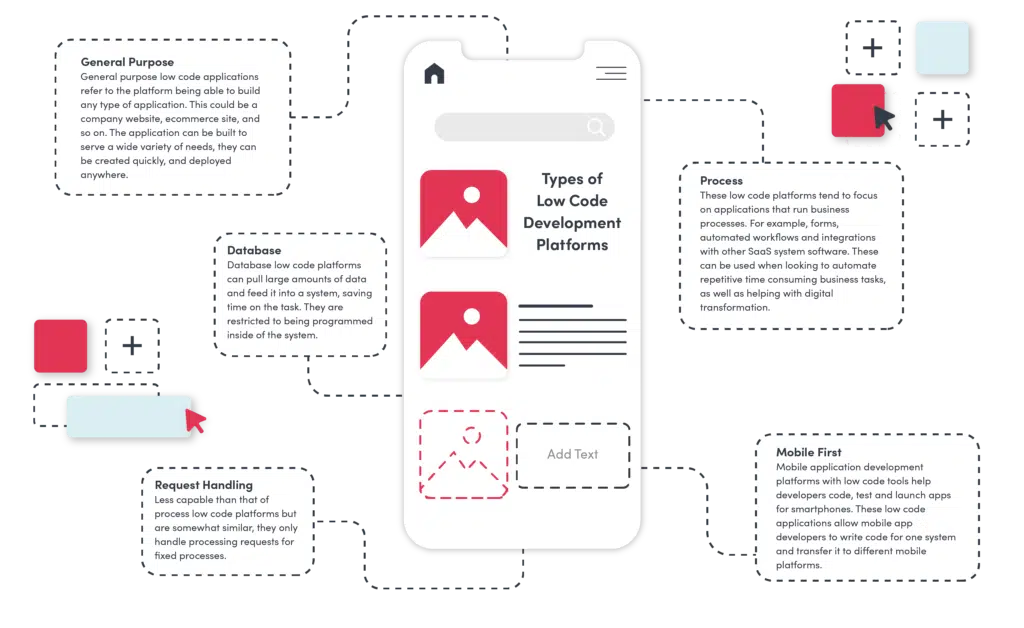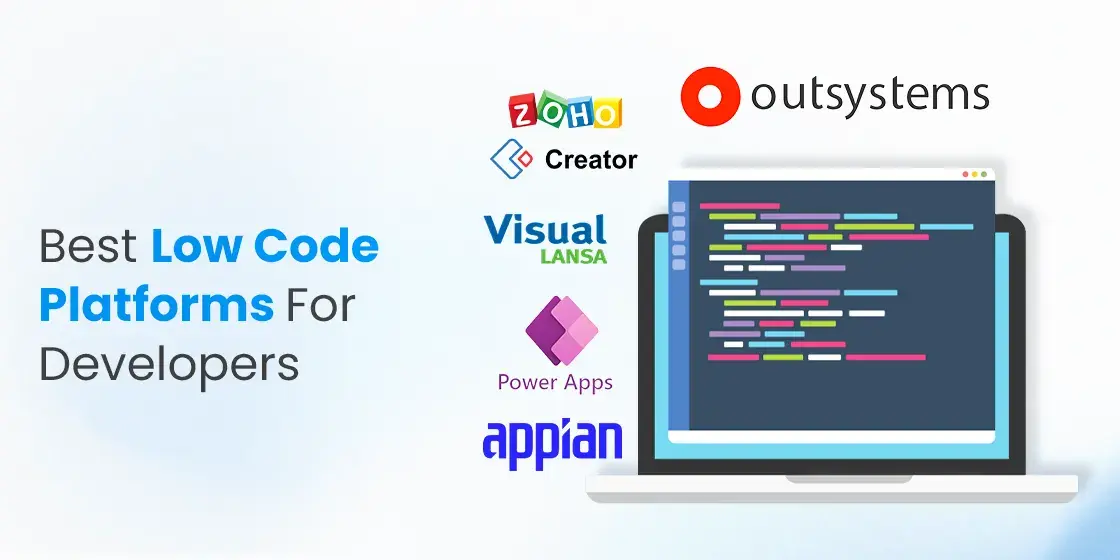Recommended Tips To Selecting Low-Code Platform Recommendations
Wiki Article
Benefits Of Low-Code Application Development Terms Of Speed
Visual Development Environment (VDE):
Drag-and-Drop Interfaces: Low-code platforms provide visual tools for designing applications. Drag-and-drop tools let developers quickly create applications without the need to write lengthy code.
Templates and pre-built components Low-code platforms have pre-built components and templates, which allow developers to quickly prototype and build applications.
Coding needs that are reduced:
Automated Code Generating: Low-code platform generates the code underneath based upon the visual models created by developers. This eliminates the requirement for manual coding and improves the speed of development.
Reusable components: Developers are able to utilize reusable components across a variety of projects, which reduces the time they're writing and testing code.
Streamlined collaboration:
Low-code development platforms are usually equipped with tools, such as deployment control, version control and testing. This allows seamless collaboration between teams.
Citizen Development - Business users, non-developers and other users can all help in the creation of applications through user interfaces that are intuitive. This eliminates the bottleneck caused by absence of experienced developers.
Rapid Iteration and Prototyping:
Fast Prototyping. Developers can design prototypes in a short time to test their ideas and receive feedback. This leads to a more efficient iteration.
Easy Modifications – The visual nature of low-code development permits easy updates and changes which speed the refinement of applications based on user feedback.
Pre-built Integrations:
API Integrations: Low-code platforms usually come pre-built with connectors for popular services and APIs. This cuts down on the time needed to integrate other systems.
Data integration tools: Tools for data integration are integrated to make it easier for the process.
Deployment of Scaling:
A lot of low-code platforms offer one-click options for deployment that reduces the amount of time and effort required to deploy applications.
Cloud-Based Platforms: Cloud-based platforms that are low-code can manage infrastructure and scaling, meaning developers can focus on application logic and function instead of the logistics of deployment.
Low-code development of applications is a quicker method to develop applications. It makes it easier and more efficient to automate many aspects of the procedure. This allows for quicker delivery and adaptation to changing requirements. Read the most popular I thought about this on Low-code Platform for application development for site advice including app modernisation, mobile development platforms, microsoft azure sql, application modernisation, microsoft azure sql, application modernization, rapid applications, rapid app development, stored sql procedures, sso azure and more.

Low-Code Development's Cost-Effectiveness Is One Of The Main Benefits.
Low-code application development has numerous advantages when it comes to cost-efficiency and efficiency, which makes it an appealing option for businesses looking to reduce their development costs while delivering high-quality applications. These are the main advantages: Reduced costs for development:
Reduced Coding: Low-code systems minimize the amount of manual coding needed and helps developers save time and energy when building applications. This means lower costs for labor.
Fewer Developers: Because low code development is faster and easier, there are fewer specialized resources for developers required. This could significantly cut down on costs for hiring and staffing.
Quicker time to market:
Accelerated Development: Low-code platforms offer visual development tools, pre-built components and other features that enable rapid development of applications. Businesses can introduce their products on the market more quickly. This can result faster revenue generation and better positioning in the market.
Rapid Prototyping: Businesses are able to quickly design prototypes and then test them, which can cut down the amount of time needed during the development process and allows for quicker iterations that are based on feedback from the users.
Lower cost of maintenance:
Simple Maintenance: Software developed using low-code platforms are generally simpler to maintain because of their standardized components and modular architecture. This can reduce the expense of maintenance and support.
Automated Updates: A lot of low-code platforms handle patches and updates in a way that is automatic and ensure that applications are secure and up-to date without needing lengthy manual intervention.
Efficient Resource Utilization:
Low-code platform contributions allow business users as well as others who are not developers to take part in the process of creating. This is a way for developers to be more democratic and allows employees and employers to collaborate, thereby reducing the dependency on high-paid developers.
Improved Utilization Of IT Resources: IT teams can concentrate on strategic projects instead of getting bogged down with mundane development work, improving the efficiency of their teams and productivity overall.
Models of pricing that are scalable:
Subscription-Based Pricing: A lot of low-code software providers offer flexible subscription-based pricing plans that grow with usage. This allows businesses to be able to align their spending with the actual demands and growth while avoiding large up-front costs.
Pay-As-You-Go: A few platforms allow pay-as-you-go. This allows businesses to only pay for resources they actually need. This is particularly beneficial for startups and small-sized businesses with a limited budget.
Reduced costs of third-party software:
Low-code platforms have built-in functions and integrations, which could reduce the cost of subscriptions to software and licensing.
Pre-Built Integrations: The accessibility and pre-built integrations for popular applications and systems reduces the need for custom development, and helps save time and money.
Increased ROI:
Increased Return on Investment Rapid development: By combining lower costs and a faster time to market, businesses are able to get a higher return on investments (ROI).
Enhanced agility. Businesses will be able to adapt quickly to evolving market conditions and consumer demands. This will help them remain relevant, and they can take advantage of any new opportunities.
Train for Less:
Low-Code platforms have user-friendly interfaces. The user-friendly and intuitive interfaces reduce the learning curve for new users. This minimizes the need for intense training programs.
Accessible Resources - A lot of low-code platforms offer extensive tutorials and training materials and also community assistance. These resources reduce the requirement for formal instruction and the associated costs.
Collaboration can be made easier.
Enhanced Collaboration Tool: The built-in collaboration tool helps improve collaboration and communication between team members. This results in faster development processes and reduces project overhead.
Unified Development Environment. A single unifying software development environment can simplify processes and cut down on the complexity and cost of managing different platforms and tools.
In the end, the value of low-code development comes in its ability to lower the cost of development and maintenance, accelerate time to market, optimize the utilization of resources, and offer flexible pricing models. These factors provide substantial economic rewards for businesses. Low-code is a fantastic option for companies that wish to make the most of their budgets, but also create robust, scalable and high-quality software. Read the best Enterprise application development with Low-code Platform tips for blog tips including cloud software applications, application modernization software, no code platforms, app dev platform, rapid action development, application modernization software, push notifications android, rapid application design, software for app development, developing mobile apps and more.

Benefits Of Low-Code App Development In Terms Limitations And Customization
Low-code development is an unbiased approach to dealing with the limitations of the system, while also providing for the possibility of personalization. Here are some benefits:
Overcoming Complexity Barriers:
Low-code platforms facilitate development by providing templates that are pre-built and other components. This allows quicker deployment and the development of more complex applications.
Many platforms have automated workflows that help developers navigate their way through the complex processes. They reduce the chance of errors and ensure uniformity.
Scalability solutions:
Built-in Scalability: Low-code platforms include many features that allow for scalable architectural design, allowing applications to take on a greater loads without major redevelopment.
Performance Monitoring: Using instruments for monitoring performance, optimization and tuning help applications scale efficiently.
Security and Compliance
Security features integrated into low-code platforms offer security measures such as encryption and access control based on role and automated compliance checks that address the most common security concerns.
Regular updates: Platforms regularly upgrade their security protocols and compliance policies. This helps ensure that applications are secure from new threats.
Options for Customization:
Extensibility:
Custom Code Integration: Low-code systems typically allow the integration of custom code (e.g., JavaScript, Python) that allows developers to extend the functionality beyond the standard offerings.
Developers can design customized plugins and modules which add features that are specifically tailored to meet the needs of specific businesses.
APIs and integration:
API Support. Complete API support enables seamless integration between other systems and services, allowing the most extensive modification and connection.
Third-Party Platforms Lowcode platforms are usually pre-built with connectors for third-party applications, which makes it simpler to integrate them and customize the app.
Flexible UI/UX design:
Customizable Interfaces: Developers have the ability to design and modify user interfaces in line with specific usability and branding criteria, resulting in a customized user experience.
Responsive Design: Built-in adaptive design capabilities ensure that applications can be adapted to different devices and screen sizes.
Business Logic Customization
Visual Workflow builders They allow developers to develop complex processes using little or no programming. They are able to design business processes and workflows using visual.
Platforms can be equipped with conditional Logic, which allows for the creation of custom scripts to address certain scenarios or business rules.
Data Management:
Custom Data Modelling: Those who develop the models develop custom models to meet particular requirements of the application. They can customize data handling to the business's needs.
Advanced Data Processing : Integration with sophisticated tools and capabilities for data processing allows flexibility in the way data is processed, analyzed and utilized in your application.
Balanced Limitations and Customization
Frameworks, Standards and Standards:
Low-code platforms promote industry standards and best practices, resulting in high-quality applications that are scalable and safe.
Governance Frameworks - Built-in governance frameworks make sure that any modifications do not compromise security, integrity or the observance of regulations.
Iterative Development:
Rapid Prototyping : Developers can quickly prototype and test customizations in response to feedback from users, and improve the app according to their requirements.
Continuous Improvement: Low-code systems permit constant improvement, allowing continuous customization and improvement as business requirements evolve.
User Empowerment
Giving Citizen Developers the tools they need: By enabling non-developers to customize their applications using intuitive user interfaces, platforms that do not require code broaden the pool of contributors who can customize and enhance applications.
Training and Support - Many platforms provide comprehensive training and resources to support users as they customize their applications, while not impacting the stability or performance of the application.
Overall, application development that is low-code provides a solid system for dealing with limitations, while providing ample opportunities for customization. This allows companies to create and maintain applications that are both functional and adapted to specific business needs. While keeping high-quality, security as well as scalability and standards.
